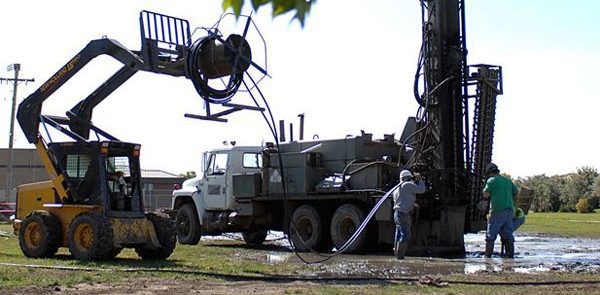No one likes high electricity bills. Especially in the height of summer or dead of winter, your HVAC unit can be a significant drain on your wallet and one of, if not the biggest line item on your electricity bill. Many of us have simply accepted those high bills as a fact of life, but the good news is that there’s a better solution.
With geothermal heating and cooling, homeowners can extract heat from the earth under their houses during winter and sink heat back into it when the weather starts warming up again. It’s a rapidly growing trend in many homeowner circles, and in this article, we’ll run you through the geothermal installation process and the geothermal requirements you’ll need to keep in mind.
 What is Geothermal Heating and Cooling?
What is Geothermal Heating and Cooling?
Tapping into the power of the earth itself, geothermal heating and cooling is a new, innovative method to keeping your house at a consistent, comfortable temperature with unmatched efficiency.
The earth below our feet at any given time remains at a solid, stable temperature year-round and in spite of the temperature or weather above. This means it’s an up-until-recently untapped temperature regulation resource that operates without any human intervention. Once installed, a geothermal heating and cooling system can passively extract and store heat and can do so intelligently based on the ambient temperature inside your home.
Geothermal Requirements
Due to its radically different nature in comparison to traditional HVAC systems, geothermal has a few notable requirements that the aforementioned traditional systems do not. You should ensure your home and lot is compatible with a geothermal system before taking it into deeper consideration.
Physical Space
 One thing to keep in mind about a geothermal system is the physical area that’s required in order to properly install it. As geothermal has everything to do with the ground around and beneath your home, excavation will almost always be necessary to at least a mild degree. Other installations, especially on more uneven or atypical ground, may require extensive excavation.
One thing to keep in mind about a geothermal system is the physical area that’s required in order to properly install it. As geothermal has everything to do with the ground around and beneath your home, excavation will almost always be necessary to at least a mild degree. Other installations, especially on more uneven or atypical ground, may require extensive excavation.
The most popular and cost-effective style of geothermal heating and cooling involves long pipes being stretched horizontally across your yard. These “loops” of pipe, as they’re known, must be installed deep into the ground, which necessitates a good deal of excavation. This is one reason geothermal is most popular among new homes.
Machine Access
Moving the amount of earth required to install a geothermal system is an intensive task, and heavy machinery will need to be utilized to make it happen. Especially if your home will be using a vertical “loop,” which requires a specialized hole boring machine, you need to ensure your home and/or its yard will be able to accommodate the machines necessary to install the necessary pipes.
Upfront Costs
Perhaps the most-talked-about requirement of a geothermal heating and cooling system is the price of entry.
A new geothermal system, considering the unit, pumps, pipe and excavation that coincides with a geothermal install, can make for a potentially daunting price tag. Costs quite a bit more than a traditional HVAC system, the costs associated with a geothermal installation may turn some homeowners away at first.
However, as with any upgrade to your home, know that a geothermal installation is an investment. What you may be paying upfront, you are guaranteed to save on air conditioning, heating, and other energy savings later down the line.
Benefits of Geothermal
With the requirements in mind, here’s what you’re really here to see: the benefits of your new geothermal system. We’ll take you through some of the biggest benefits to your new system, and let you see for yourself how good of an investment geothermal can be.
Unrivaled Efficiency
Minus the power needed to run the pump, which performs the heat exchange in your pipe loop, geothermal needs very little power to run. Compare this with a traditional HVAC unit, which needs to actively draw electricity to actively cool or heat the air, geothermal does this process passively — all on its own. The removal of this active, constant process is one of the biggest source of energy savings geothermal provides over time.
It’s Kind to the Environment
To those wanting to do good to their environment and the world, geothermal is a great investment. The vastly superior energy efficiency of geothermal isn’t just good to your wallet, it’s good to the planet, as it requires far less fuel to be burned at your local power plant in order to run. Your yard will also make for the greenest conceivable way to store heat — it’s a much more environmentally-friendly storage medium than anything manmade, and it won’t ever disrupt your lawn or other yard plants.
Tax Credits
In the US, the federal government is actively incentivizing new geothermal installations for the reasons mentioned previously. In addition to the money you’ll be saving on electricity, you may find yourself saving on your yearly taxes as well.



